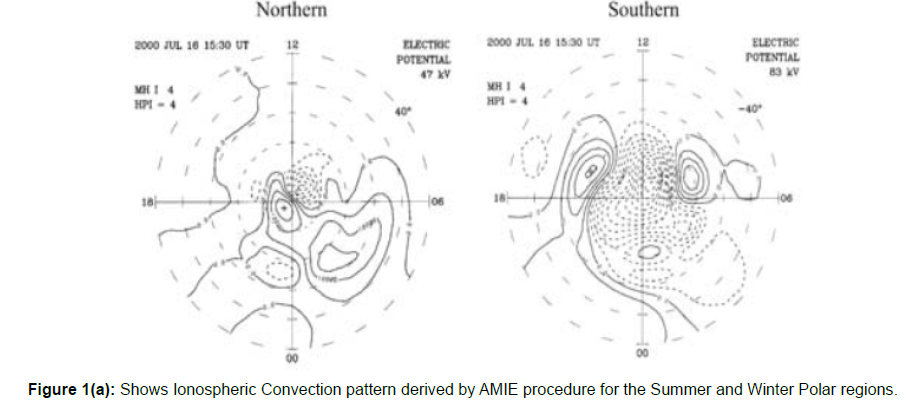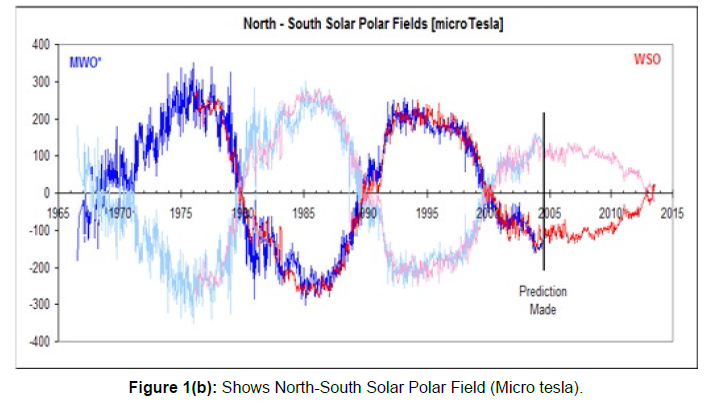Solar Wind-Magnetosphere-Ionosphere Coupling on Polar Cusp
Received: 03-Apr-2023 / Editor assigned: 05-Apr-2023 / PreQC No. jescc-23-94063 (PQ) / Reviewed: 19-Apr-2023 / QC No. jescc-23-94063 / Revised: 21-Apr-2023 / Manuscript No. jescc-23-94063 (R) / Accepted Date: 28-Apr-2023 / Published Date: 28-Apr-2023 DOI: 10.4172/2157-7617.1000673 QI No. / jescc-23-94063
Abstract
The Earth’s magnetosphere and upper atmosphere can be greatly perturbed by variations in the solar luminosity caused by disturbances on the Sun. The polar cusp ionosphere important part of near- earth space which best monitored by ground based observation made in the remote polar regions, Antratica seems certain to play a key role in the future exploration. The polar region is characterized by direct entry of solar wind particles along magnetic field line projecting to the dayside magnetopause (outer boundary of the magnetosphere). Thus polar cusp ionosphere provides splendid window for examining processes transferring solar wind mass and momentum to the magnetosphere. The state of near-Earth space environment is governed by the Sun and is very dynamic on all spatial and temporal scale. The geomagnetic field which protects the Earth from solar wind and cosmic rays is also essential to the evolution of life; its variations can have either direct or indirect effect on human physiology and health state even if the magnitude of the disturbance is small. Geomagnetic storms are seen at the surface of the Earth as perturbations in the components of the geomagnetic field, caused by electric currents flowing in the magnetosphere and upper atmosphere. Ionospheric and thermospheric storms also result from the redistribution of particles and fields. Global thermospheric storm winds and composition changes are driven by energy injection at high latitudes. Storm effects may penetrate downwards to the lower thermosphere and may even perturb the mesosphere. Many of the ionospheric changes at mid-latitude can be understood as a response to thermospheric perturbations. The transient bursts of solar energetic particles, often associated with very large solar flares, have been observed to have effects on the Earth’s middle and lower atmosphere, including the large-scale destruction of polar stratospheric and tropospheric ozone. In the present, we have discussed effect of solar influences on earth’s magnetosphere and upper atmosphere that are useful to space weather and global warming.
Keywords
Magnetosphere; Ionosphere; Polar Cusp; Solar wind interaction; Geomagnetic storms
Introduction
Polar Cap and Auroral Zone Geomagnetic Indices. The polar Cap index is characterstics of the Polar Cap magnetic activity generated by geoeffective Solar Wind acting on the Magnetosphere. The index is derived by magnetic data of only two stations Thule and Vostak located in northern (PCN) and Southern (PCS). Near –Pole regions, in 2013 the international of Geomagnetisim and aeronomy (IAGA) recommended to international scientific community to use PC Index as a proxy for energy that eneter that into magnetosphere during Solar Wind Magnetosphere-ionosphere Coupling. The Procedure adopt in AARI and DTU. Provideon line calculation of the PCS and PCN indices corresponding to geo effective interplanetary electric Field Ekl value irrespective of time, season and Solar Cycle (Figure 1a).
The polar cap (PC) index is measure of the high-latitude geomagnetic disturbances due to Hall Effect field-aligned currents. The index is well correlated with the auroral electrojet AL and AU indices (correlation with the PC index is 76% and 60% resp.). Several type databases relate to the PC to the AL and AU indices in the winter time, when the ionospheric conductivity is mostly due to precipitating particles of the field- aligned currents.
The Polar Cap (PC) index measure geomagnetic disturbances at the polar cap which are due to ionospheric and Field-aligned Currents [1, 2].The Former ones are hall Currents induced by the field time convection and form a part of DP2 current system. The relative importance of each current type depends on the ionospheric conductivity which is modulated on the dayside by the seasonally and daily varying solar illumination and on the night side by particle precipation. The index is derived from Horizontal geomagnetic disturbances HDP2 at a standard high-latitude station which for the Northern polar cap is THULE at 83.3˚N (a separate index is calculated for Southern cap.). The PC index was designed to measure the part of HDP2 disturbances due to magnetosphere field aligned convection. Convection is assumed to be linearly correlated with Solar wind input and hence PC index is the part of HDP2 disturbances correlated with solar wind input and normalized to its unit (mV/m). The relation between the PC index and solar wind input varies as a function of season and UT [1, 2]. The second source for Polar cap geomagnetic disturbances is field aligned currents which become dominant in the winter and summer time, when the polar cap is dark and convection-induced currents wane significantly. At the time the PC index becomes well-correlated with the AU and AL indices. The indices measure the geomagnetic effects of the auroral electro jets, which connect the foot point of field aligned currents in the ionosphere [3, 4, 5, 6, 7]. In winter (November-February) the correlation with AL varry with UT in The range 85-90% and AU 60-85% [1, 2]. Intermediate correlation occurs during the enquinax periods.Geomagnetic disturbances due to other current types, for example the DPY current, Have a negligible correlation with the PC index [2]. The database of PCThule is from November 1, 1978 to February 28,1979.The 1-minAL/ AU indices Compete,the 15- min PC index,and the 5-min ISEE-3- Measured solar wind input, are linearly interpolated to time resolution of 2.5 min (Figure 1b).
The correlation is maximum(77%) when PC is shifted in time to precede AL by 7.5 min. but individual events each index may precede the other by more than 10 minutes. the PC-AU correlation is 66% for individual UT(Vennerstroem et al.,1991). And the correlation is maximum AL-AU correlation occurs when AL leads by 10 min.) Thus typical disturbances begin at polar latitudes on the night side and then spread equatorward reaching the auroral zone stations in several minutes [8]. Even when AU starts increasing before PC, the PC index reaches its maximum level faster. Which might shows a relation between rate of polar cap expansion and driven and loadingunloading effects, but we did not find systematic dependences. The high correlation between geomagnetic activity from the polar cap and auroral zone shows that the two regions are strongly coupled. The electromagnetic coupling allows the two magnetospheric regions to produce Coordinated, organized activity [9, 10].
The PC index is expected to rapidly become important for specification of the magnetospheric state, and useful in scientific and Space Weather applications.
Conclusion
Solar wind-magnetosphere-ionosphere coupling are dominated with solar wind Plasma mediated by magnetic reconnection at magnetopause interface. As consequences earth’s magnetosphere dynamics depends primarily on concurrent orientation of the interplanetary magnetic field. The polar Cusp is region in which the magneto sheath plasma has direct access to the Ionosphere. It is exisiting weather the interplanetary magnetic field is northward or southward. In no-reconnecting magnetosphere the location of the cusp depend on the shape of magnetosphere but when the magnetosphere reconnection with either southward or north ward Interplanetary magnetic field the location of the polar cusp altered polarity.
Solar wind-magnetosphere-ionosphere coupling has major relevance as the plasma medium in which space craft must designed to operate in space. Using e.g. for communication, Navigation, meterology and defence.
Key point of conclusion of research paper.
Demonstration of close relationship between Solar wind-parameter, Polar Cap (PC) indices and Major magnetospheric current system.
Specification of relation between polar cusp (PC) auroral Al, Au and SML and ring current Dst, SYm-H, Asy-H indices.
Acknowledgement
I hereby acknowledge and support of all academic and Nonacademic staff of department of Physics in APS Univ .Rewa (MP), India for success of research study.
The authours would like to acknowledge the encouragement and motivation of Dr. Peter Carter work as climate agency institute, and Dr. Anil Bhradwaj sir, director Physical research laboratory Ahemedabad, India
Competing Interest and Disclousure of conflict interest
The author declear that they have no competing interest Athour discloused that there is no conflict interest in carrying out this research study.
References
- Troschichev OA (1988) the physics and meaning of the exisiting and proposed high-latitude geomagnetic indices. Annales Geophysicae 6: 601-610.
- Vennerstroem, Friss-Christension OA, Troshichev, Andrezen VG (1991) Comparision between the polar cap, PC, and auroral indices AE, AL, and AU. J of Geophys Res 96: 101-113.
- Mayud PN, Derivationevalution of The AE indices.
- Holzer RE, JA Slavin (1981) Processes influencing the diurnal variation of the AL index and its reliability. J Geophys Res 86: 8977-8980.
- Akasofu, Ahn Y, Kamide, JH Allen (1983) A note on the accuracy of auroralelectrojet indices. J Geophys Res 88: 5769-5772.
- Baum Johann, W Merits (1986) Limitation of the Use of geomagnetic indices in Solarwind-magnetospherecouplingstudies insolar Wind-Magnetosphere. Tokyo Terra Scientific 3-15.
- Kroehl HW (1989) A critical evalution of the AE indices. J Geomag Geooelectr 41: 317-329.
- Rostoker G, TD Phan (1986) Varriation of Aurroralelectrojet spatial location as a function of the level of magnetospheric activity.
- Baker DN, AJ Klimas, RL McPherron, J Büchner (1990) the evolution from weak to strong geomagnetic activity: An interpretation in term of deterministic Chaos. Geophys Res Lett 17.
- Klimas AJ, Vassiliadis D, Baker DN, Roberts DA (1996) the organized nonlinear Dynamics of the magnetosphere. J Geophys Res 101: 13089.
Indexed at, Google Scholar, Crossref
Indexed at, Google Scholar, Crossref
Indexed at, Google Scholar, Crossref
Indexed at, Google Scholar, Crossref
Citation: Mishra RK, Dubey SC (2023) Solar Wind-Magnetosphere–Ionosphere Coupling on Polar Cusp. J Earth Sci Clim Change, 14: 673. DOI: 10.4172/2157-7617.1000673
Copyright: © 2023 Mishra RK, et al. This is an open-access article distributed under the terms of the Creative Commons Attribution License, which permits unrestricted use, distribution, and reproduction in any medium, provided the original author and source are credited.
Select your language of interest to view the total content in your interested language
Share This Article
Recommended Journals
Open Access Journals
Article Tools
Article Usage
- Total views: 2009
- [From(publication date): 0-2023 - Oct 13, 2025]
- Breakdown by view type
- HTML page views: 1708
- PDF downloads: 301


